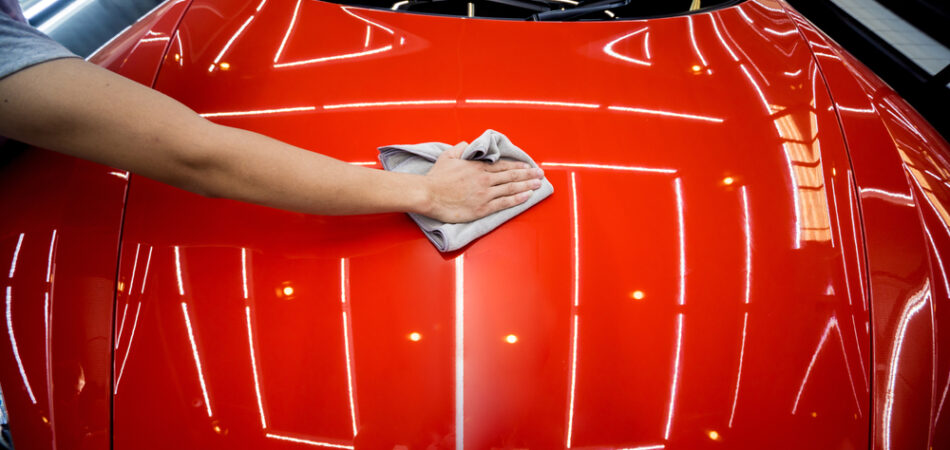What to Anticipate During Your Ceramic Coating Application Process
What to Anticipate During Your Ceramic Coating Application Process
Blog Article
The Function of Ceramic Coating in Securing Your Automobile's Paint From Environmental Damage
Ceramic finishing has actually arised as a sophisticated solution for automobile owners looking for to maintain the integrity of their vehicle's outside. As we discover the nuances of ceramic finishing, it becomes noticeable that the option to execute this protective step might dramatically affect your lorry's durability and aesthetic.
What Is Ceramic Covering?
Ceramic covering is an advanced fluid polymer applied to the exterior surface areas of a lorry, made to give a resilient layer of protection for the paint. This innovative remedy develops a chemical bond with the automobile's factory paint, developing a hydrophobic and durable guard. The covering contains nanoparticles that fill out the tiny imperfections in the paint, resulting in a smooth surface area that enhances shine and gloss.
Generally, ceramic coatings are offered in numerous solutions, enabling different levels of protection and longevity. While some products can last for numerous months, others offer defense for a number of years, depending on the thickness of the application and environmental factors. The application process requires thorough preparation, consisting of washing, sanitizing, and brightening the lorry's surface area to make certain ideal bond of the coating.

Advantages of Ceramic Coating
One of the key advantages of applying a ceramic finish is the extraordinary defense it provides to auto paint. This advanced coating develops a durable layer that shields the lorry's surface from a selection of ecological risks, consisting of UV rays, acid rainfall, bird droppings, and tree sap. By offering this durable defense, ceramic finishings substantially minimize the threat of fading and etching, protecting the auto's aesthetic allure gradually.
In enhancement to protection, ceramic coverings are renowned for their hydrophobic residential properties, which fend off water and dirt, making it much easier to maintain a tidy car. This self-cleaning impact reduces the frequency of washing, conserving both time and sources. Additionally, ceramic coverings enhance the depth of the paint's gloss, resulting in a lively and sleek appearance that raises the overall look of the car.
An additional noteworthy advantage is the longevity of ceramic coatings. Unlike traditional waxes or sealants that require frequent reapplication, ceramic coverings can last numerous years, offering an economical service for automobile owners looking for lasting security. Generally, spending in ceramic finish brings about boosted durability, reduced maintenance, and continual aesthetic allure for automotive paint.
Exactly How Ceramic Finishing Works
A ceramic layer runs with a chemical bonding procedure that develops a protective layer on the lorry's paint surface. This ingenious remedy uses advanced nanotechnology, where tiny particles of silica are suspended in a liquid type - ceramic coating. Upon application, these particles bond with the factory paint, creating a durable and hydrophobic layer that enhances the lorry's surface area
The primary component of ceramic coatings, silicon dioxide (SiO2), contributes to the finish's stamina and durability. When treated, the finishing changes right into a hard, glass-like coating that guards the paint from ecological impurities such as dust, UV rays, bird droppings, and tree sap. This molecular bond results in a surface that is not just immune to scratches but likewise simpler to clean up, as dirt and gunk are much less most likely to stick.
Additionally, the hydrophobic residential or commercial properties of ceramic finishes trigger water to grain and slide off, reducing the chances of water areas and natural resource. This safety obstacle properly prolongs the life of the paint and preserves the car's visual appeal, using car proprietors a long-lasting option for paint protection.
Application Process of Ceramic Layer
When taking into consideration the application of ceramic finishing, prep work is essential to achieving optimum results. The initial step entails extensively washing the vehicle to eliminate dust, gunk, and contaminants from the surface area. This frequently includes a decontamination process utilizing clay bars or chemical cleansers to make certain the paint is completely clean. Any imperfections or scratches ought to be attended to at this stage, as the covering will certainly bond with the surface area below.

Ceramic finish is then applied in small sections, generally using an applicator pad. It is critical to operate in even strokes, ensuring consistent coverage. The finishing should be permitted to treat for a specified time, which can vary depending on the item used. After the initial application, a high-quality microfiber towel is utilized to rub the surface, enhancing gloss and ensuring a smooth surface. The vehicle ought to be left to heal in a controlled atmosphere to allow the coating to completely bond with the paint.
Long-Term Maintenance and Care
Attaining an effective ceramic finishing application my response establishes the foundation for long-term security, but correct maintenance is crucial to preserving its advantages. Regular cleaning is essential; using a pH-neutral vehicle hair shampoo will aid preserve the covering's stability without creating damages. Stay clear of automated auto washes that use rough products, as they can compromise the finish's surface.

In addition, applying a ceramic covering maintenance spray can enhance the existing layer, providing an added boost in protection her response and luster. It's advisable to execute this every 3 to six months, relying on ecological direct exposure.
Lastly, car park in shaded areas or using vehicle covers can stop extended direct exposure to hazardous UV rays and ecological contaminants, even more prolonging the life of your ceramic layer. By sticking to these upkeep techniques, you can guarantee your automobile's surface continues to be protected and aesthetically appealing for many years to come.
Verdict
In recap, ceramic layer functions as a crucial protective action for automobile paint, click this successfully protecting vehicles from a range of environmental dangers. Its capability to produce a robust hydrophobic barrier not only boosts aesthetic allure however additionally considerably lowers the frequency and intensity of maintenance called for. The resilient nature of this advanced polymer highlights its worth in preserving lorry integrity and look, eventually adding to a more aesthetically appealing and resilient vehicle coating.
Ceramic finishing is a sophisticated liquid polymer applied to the outside surfaces of a car, created to provide a resilient layer of security for the paint. Ceramic layers boost the deepness of the paint's gloss, resulting in a refined and lively appearance that raises the general look of the automobile.
A ceramic covering runs through a chemical bonding process that develops a protective layer on the vehicle's paint surface area.The primary component of ceramic coatings, silicon dioxide (SiO2), adds to the finish's strength and resilience.In recap, ceramic finish offers as a vital safety procedure for automotive paint, properly protecting cars from a range of ecological threats.
Report this page